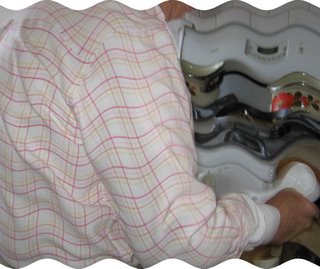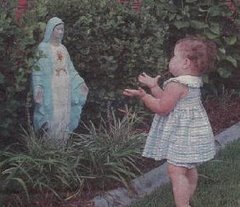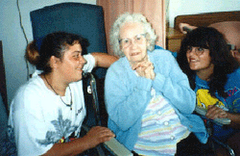Jun 30, 2006
A Local Saintly Lady and $26
This story was told to me many, many years ago by Mrs. Julia Cornish (deceased), mother of Fr. Ron Cornish. When Mrs. Cornish was raising her large family, she sometimes had a difficult time financially. Once she desperately needed $26 (an exact amount), and there appeared no source for this relatively large sum. She was washing clothes in her basement thinking of a saint she could entreat to obtain the necessary $26. Mrs. Cornish decided she had already asked many, many favors from her favorite saints, and wondered what new saint could she pray to. She then remembered Mrs. Wolf, who had recently died.
Mrs. Wolf's husband did not make or give his wife sufficient money to clothe and feed their many children, and so she accepted gifts of excess food donated to the Franciscan nuns who operated the orphanage at nearby St. John the Baptist parish. She had to conceal these necessary gifts because her husband was insistent that his family not accept charity. Mrs. Wolf had a very hard life, became quite ill while still relatively young, and died leaving many children.
So Mrs. Cornish, when faced with the critical need for $26, thought that she would pray to Mrs. Wolf. She knew Mrs. Wolf was a very good wife and mother, had suffered a great deal without complaining, offered those sufferings to God, and was certainly a saint in heaven. So while continuing to wash clothes, Mrs. Cornish asked Mrs. Wolf to beseech God for the favor of $26.
Almost immediately, said Mrs. Cornish, her doorbell rang upstairs and when she answered it, the postman handed her an envelope. He said that even though he didn't usually ring the doorbell when delivering the mail, he knew she would be eager to receive the letter from one of her sons who was on a Navy ship. When Mrs. Cornish opened the mail, it contained the exact $26 that she had prayed for to Mrs. Wolf. The Navy son explained that he had just received his pay, and that he was sending the extra money to his mother.
Jun 28, 2006
Stories about the Prayer to St. Michael
The first story I remember was told to me by Sr. Mary Vincentine (deceased) of the Sisters of Charity of Leavenworth. She described a pilgrimage to Rome in the mid-1960’s where she met some Germans. Sister stated that the German pilgrims were extremely concerned because the prayer to St. Michael also had been forbidden by Hitler at the time of World War II. Most readers understand the chaos and devastation that occurred in Germany because of that terrible war. And since 1964, has anyone in the Church not been affected by the disasters in the Church?
The second story was told to me a long time ago by a good priest. A newly assigned pastor learned that the women in the altar society fought with each other most of the time. At the first meeting, the pastor observed an unnatural disfunction and disorder among the women, and he resolved to do something about it. So at the start of the next meeting, he prayed and then blessed them in a moment of silence. It was during this time that he silently said a private prayer of exorcism--the prayer invoking St. Michael's help in defeating the devil. The altar society meeting that evening was totally different. Now the women behaved as good religious women should, worked together effectively, and accomplished a lot of good work. The new pastor continued to pray to St. Michael at subsequent meetings, and the altar society proved to be a great asset to the parish.
Hopefully, the Pope will reinstate the great prayer to St. Michael the Archangel so that this heavenly warrior will defend the Church against a multitude of enemies. In the meantime, we should say the prayer privately whenever (and before!) the need arises.
Jun 27, 2006
Beware the Church Pendulum
Foucault's Pendulum is famous because it demonstrates the earth rotates on its axis. A universal joint allows a pendulum to rotate freely around a top fixed point as it swings. A pendulum stops moving at the end of the swing when inertia is finally overcome by gravity.
For a few swings, the pendulum appears to swing back and forth in the same line, as traced on the floor. But as observed over the period of a day (at the north and south poles), the path of a pendulum rotates 360 degrees, corresponding to the rotation of the earth on its axis. If the earth were stationary, the pendulum at any location on earth would swing back and forth always in the same direction. And that doesn't happen, except at the equator where the earth does not rotate under the pendulum. In all locations, the pendulum always swings back and forth in exactly the same direction, and it only appears that the pendulum is changing direction.
History repeats itself in cycles resembling the swing of a pendulum. For example, modern heresies are really old heresies that develop slowly, flourish during a rapidly passing time, then decay slowly.
History has a certain inertia--an object in motion tends to stay in motion. Once an ideology or era begins to flourish, it is difficult to stop--similar to the midpoint of the pendulum swing.
History seems to stop and reverse itself only at the extremes of ideology or movement--the endpoints of a pendulum swing.Finally, the direction of history appears to change at times--but that is dependent on where we stand.
For some time, I've been concerned that when the pendulum of the historical Church (not the eternal Church!) swings back from liberalism, that it will swing so hard that it will quickly pass a reasonable position. For example, the Church was too severe before about 1960 (in my opinion), and required one to abstain from drinking all water and eating no food after midnight if one wanted to receive Holy Communion. Consequently, only a handful of Catholics received Holy Communion at later Masses on Sunday morning.
The rules were changed about 1960 to forbid water within one hour and food within three hours of Holy Communion. The new moderate rules resulted in significantly more Communions at late morning Sunday Masses. Moreover, people who traveled a long distance to a Mass, especially in hot climates, were able to appropriately nourish themselves with water and food and still go to Holy Communion.
Within a very few years, the rules were changed again to require only one hour abstention from food, and water without limit, before reception of Holy Communion. The new rules completely abandoned any requirements for real sacrifices to receive Holy Communion.
As observed above, once the pendulum passed the reasonable middle position (between somewhat harsh laws and very liberal laws), it moved very quickly to a very liberal position where it has stayed for over 30 years. Now to the next problem--the return of the pendulum!
A small 'critical mass' is now available for a resurgence of traditionalism within the Church. It has now passed the pendulum endpoint and is swinging slowly back to the center. Frankly, history tells us the pendulum will begin to move more rapidly and won't stop at the reasonable middle. We can expect that it will now swing to the other extreme and remain there for a considerable period. The swing to the other side will take longer than the remainder of my lifetime, but my grandchildren will see it.
Jun 25, 2006
The Lumberjack and the Sacred Heart
Stories are the best way to teach the Catholic Faith. Ask yourself==What do you remember from sermons--even recent ones? Or from school lessons of many years ago? Probably only two types of instruction--either stories or what was memorized.







